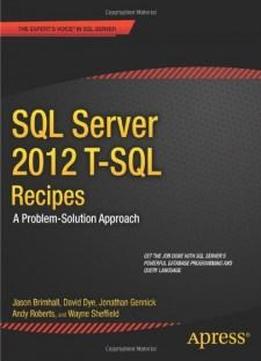
SQL Server 2012 T-SQL Recipes: A Problem-Solution Approach (Recipes Apress)
by Jonathan Gennick /
2012 / English / PDF
6.9 MB Download
SQL Server 2012 T-SQL Recipes
is an example-based guide to the Transact-SQL language that is at the core of SQL Server 2012. It provides ready-to-implement solutions to common programming and database administration tasks. Learn to create databases, insert and update data, generate reports, secure your data, and more. Tasks and their solutions are broken down into a problem/solution format that is quick and easy to read so that you can get the job done fast when the pressure is on.
Solutions in this book are divided into chapters by problem domain. Each chapter is a collection of solutions around a single facet of the language such as writing queries, developing triggers, and applying aggregate functions. Each solution is presented code-first, giving you a working code example to copy from and implement immediately in your own environment. Following each example is an in-depth description of how and why the given solution works. Tradeoffs and alternative approaches are also discussed.
Focused on solutions: Look up what you need to do. Learn how to do it. Do it.
Current: Newly updated for SQL Server 2012
Comprehensive: Covers all common T-SQL problem domains
What you’ll learn
Create databases, tables, and indexes
Query and manipulate data
Store and manage XML inside the database
Move business logic into the database
Resolve common performance problems.
Build reports that matter to your business.
Perform common backup and recovery tasks.
Who this book is for
SQL Server 2012 T-SQL Recipes
is aimed at technically-oriented users of SQL Server desiring to extract the full power of the platform through it's powerful, built-in programming and scripting language. Target readers include developers who use Microsoft SQL Server 2012 as their back–end database, and the database administrators who create, manage, and secure those databases.
Table of Contents
Getting Started with SELECT
Elementary Programming
Nulls and Other Pitfalls
Combining Data from Multiple Tables
Grouping and Summarizing
Advanced SELECT Techniques
Query Techniques for Reporting
Inserting, Updating, Deleting
Working with Strings
Working with Dates
Working with Numbers
Transactions, Locking, Blocking, Deadlocking
Managing Tables
Managing Views
Managing Indexes
Managing Large Tables
Stored Procedures
User-Defined Functions
Triggers
Error Handling
Query Performance
Hints
Index Tuning and Statistics
XML
Files, Filegroups, and Integrity
Backup
Recovery
Principals and Users
Securables and Permissions
Objects and Dependencies











